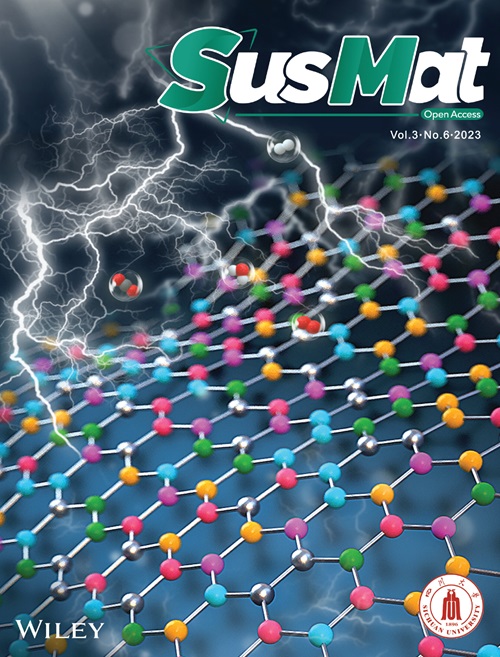利用二氧化碳和含氮物质电催化合成 C-N 偶联化合物
IF 18.7
1区 材料科学
Q1 CHEMISTRY, MULTIDISCIPLINARY
引用次数: 0
摘要
利用二氧化碳和含氮物质电催化合成 C-N 偶联化合物,不仅为实现碳中和和减少环境污染提供了有效途径,还为合成尿素、酰胺和胺等有价值的化学品开辟了一条途径。这种创新方法扩大了电催化二氧化碳还原的应用范围和产品种类,使其超越了简单的碳质物种,成为一个发展迅速的领域。本综述总结了以 N2、NO2- 和 NO3- 为含氮物质的电催化尿素合成的研究进展,并探讨了以 CO2 和含氮物质为原料电合成酰胺和胺的新趋势。此外,还强调了这一领域的未来机遇,包括氨基酸和其他含 C-N 键化合物的电合成、水氧化以外的阳极 C-N 偶联反应以及相应反应的催化机理。这篇重要综述还捕捉到了旨在加速发展电化学 C-N 偶联反应的见解,证实了这种电化学方法优于传统技术。本文章由计算机程序翻译,如有差异,请以英文原文为准。
Electrocatalytic synthesis of C–N coupling compounds from CO2 and nitrogenous species
The electrocatalytic synthesis of C–N coupling compounds from CO2 and nitrogenous species not only offers an effective avenue to achieve carbon neutrality and reduce environmental pollution, but also establishes a route to synthesize valuable chemicals, such as urea, amide, and amine. This innovative approach expands the application range and product categories beyond simple carbonaceous species in electrocatalytic CO2 reduction, which is becoming a rapidly advancing field. This review summarizes the research progress in electrocatalytic urea synthesis, using N2, NO2−, and NO3− as nitrogenous species, and explores emerging trends in the electrosynthesis of amide and amine from CO2 and nitrogen species. Additionally, the future opportunities in this field are highlighted, including electrosynthesis of amino acids and other compounds containing C–N bonds, anodic C–N coupling reactions beyond water oxidation, and the catalytic mechanism of corresponding reactions. This critical review also captures the insights aimed at accelerating the development of electrochemical C–N coupling reactions, confirming the superiority of this electrochemical method over the traditional techniques.
求助全文
通过发布文献求助,成功后即可免费获取论文全文。
去求助
来源期刊
自引率
4.20%
发文量
0
期刊介绍:
SusMat aims to publish interdisciplinary and balanced research on sustainable development in various areas including materials science, engineering, chemistry, physics, and ecology. The journal focuses on sustainable materials and their impact on energy and the environment. The topics covered include environment-friendly materials, green catalysis, clean energy, and waste treatment and management. The readership includes materials scientists, engineers, chemists, physicists, energy and environment researchers, and policy makers. The journal is indexed in CAS, Current Contents, DOAJ, Science Citation Index Expanded, and Web of Science. The journal highly values innovative multidisciplinary research with wide impact.

 求助内容:
求助内容: 应助结果提醒方式:
应助结果提醒方式:


